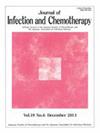Evaluation of the clinical characteristics, laboratory parameters, and antibiotic treatment in patients diagnosed with tularemia
IF 1.9
4区 医学
Q3 INFECTIOUS DISEASES
引用次数: 0
Abstract
Introduction
This retrospective, cross-sectional, multi-center study aimed to evaluate the impact of laboratory results and treatments on the treatment response in patients diagnosed with tularemia.
Methods
The study included 190 adult patients diagnosed with tularemia between November 2023 and June 2024.
Results
67.9 % were female, mean age was 45.8 ± 14.9 years. The most frequently detected symptoms were sore throat (74.2 %), fatigue (71.6 %), and neck swelling (56.3 %). The most common form of tularemia was oropharyngeal (82.6 %) and glandular (14.2 %). The most used monotherapy was ciprofloxacin (80.5 %, n = 136), and combination therapy was streptomycin-ciprofloxacin (81.0 %, n = 17). Treatment failure was observed in 29 patients (15.2 %). No difference was found between patients who responded and didn't respond to treatment regarding laboratory parameters. Lymph node drainage or excision was performed in 47 patients (23 %). Suppurative lymphadenitis, abscess, necrosis, and conglomerate lymphadenopathy were more common in the lymph node drainage group. Reactive lymph nodes were more common in the group without lymph node drainage. There was no difference between the two groups regarding laboratory parameters of patients with and without lymph node drainage. The duration of antibiotic treatment was longer in patients who underwent lymph node drainage than in those who didn't.
Conclusion
Radiological evaluation of lymph nodes upon hospital admission, in addition to antibiotic therapy during treatment, may help predict which patients are more likely to require surgical drainage. Laboratory parameters may not provide significant benefits in predicting the need for lymph node drainage and long-term treatment did not affect the treatment response.
评估图拉里病毒感染者的临床特征、实验室参数和抗生素治疗。
简介:这是一项多中心回顾性横断面研究,旨在评估实验室结果和治疗方法对确诊为土拉菌病患者治疗反应的影响:这项回顾性、横断面、多中心研究旨在评估实验室结果和治疗方法对确诊为土拉菌病患者治疗反应的影响:研究纳入了2023年11月至2024年6月期间确诊为土拉菌病的190名成年患者:67.9%为女性,平均年龄为(45.8±14.9)岁。最常见的症状是喉咙痛(74.2%)、疲劳(71.6%)和颈部肿胀(56.3%)。最常见的土拉菌病是口咽(82.6%)和腺型(14.2%)。最常用的单一疗法是环丙沙星(80.5%,人数=136),联合疗法是链霉素-环丙沙星(81.0%,人数=17)。29名患者(15.2%)治疗失败。在实验室指标方面,对治疗有反应和没有反应的患者之间没有差异。47名患者(23%)进行了淋巴结引流或切除术。在淋巴结引流组中,化脓性淋巴结炎、脓肿、坏死和集合性淋巴结病更为常见。无淋巴结引流组中反应性淋巴结更常见。淋巴结引流组和未引流组患者的实验室指标没有差异。接受淋巴结引流术的患者接受抗生素治疗的时间长于未接受引流术的患者:结论:入院时对淋巴结进行放射学评估,再加上治疗期间的抗生素治疗,可能有助于预测哪些患者更有可能需要手术引流。实验室参数在预测淋巴结引流的必要性方面可能并无明显益处,长期治疗也不会影响治疗反应。
本文章由计算机程序翻译,如有差异,请以英文原文为准。
求助全文
约1分钟内获得全文
求助全文
来源期刊

Journal of Infection and Chemotherapy
INFECTIOUS DISEASES-PHARMACOLOGY & PHARMACY
CiteScore
4.10
自引率
4.50%
发文量
303
审稿时长
47 days
期刊介绍:
The Journal of Infection and Chemotherapy (JIC) — official journal of the Japanese Society of Chemotherapy and The Japanese Association for Infectious Diseases — welcomes original papers, laboratory or clinical, as well as case reports, notes, committee reports, surveillance and guidelines from all parts of the world on all aspects of chemotherapy, covering the pathogenesis, diagnosis, treatment, and control of infection, including treatment with anticancer drugs. Experimental studies on animal models and pharmacokinetics, and reports on epidemiology and clinical trials are particularly welcome.
 求助内容:
求助内容: 应助结果提醒方式:
应助结果提醒方式:


